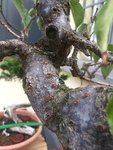LeoMame
Yamadori
Hello Bonsai people, I'm writing to you in order to understand if what I see on the bark of my Prunus Mume is ok or should I be worried.
I purchased the tree one month ago and the bark was exactly like this; I inquired about it, out of curiosity (and ignorance) and the seller told me it was normal and that the mume's bark is like this. It's its character, that's what he said.
Anyhow, I checked online and I couldn't find a correspondence between my mume's orange/brown dots on the bark with any other mume so I started to think it might be something not exactly "normal".
I attached some good pictures, let me know what you think about this.
Thank you very much!
I purchased the tree one month ago and the bark was exactly like this; I inquired about it, out of curiosity (and ignorance) and the seller told me it was normal and that the mume's bark is like this. It's its character, that's what he said.
Anyhow, I checked online and I couldn't find a correspondence between my mume's orange/brown dots on the bark with any other mume so I started to think it might be something not exactly "normal".
I attached some good pictures, let me know what you think about this.
Thank you very much!








